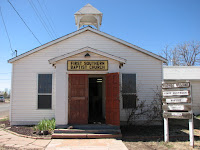











Ash Fork seemed like a good place to boondock for the night. We were headed east on I-40 in Arizona as the sunlight began to fade. The interstate exit sign told us we could exit at Ash Fork onto Business 40, an indication that there just might be a big enough place for us to park the Prevost for the night. We only took one loop through town before finding a large industrial lot. We parked between the train tracks and a metal building barely as long as our bus.
In the remaining moments of sunlight, we walked the main street, Historic Route 66. You can still find traces of businesses that thrived when Route 66 served as a main artery for traffic. A faded picture of a strawberry ice cream cone decorated the boarded-up restaurant. Signs for several motel motor lodges show vacancy but no vacationers stay in these run down rooms anymore. Weeds grow high around the door to the antique store that closed years ago. An old car mounted near a large sign Route 66 teetered on the roof of a gas station that had long ago pumped its last gallon. A collector’s antique car sat curbside in front of a Main Street house. The owner tinkered with another old relic out back. Some vehicles looked abandoned like the parked bus displaying in its window the most recent valid registration - the year 1975.
Though Ash Fork looked like a ghost town, signs of life could be found. In Zeller’s Market, a teenager dressed in a tux for the high school prom withdrew cash from an ATM. We bought a six-pack of cold Budweiser in the little store. The Ash Fork Library looked like once of the newest buildings in town. A playground and community park with picnic tables looked relatively new too.
On Sunday morning, I heard three musicians practicing hymns for a Sunday service. Their pastor told me some weeks as many as 40 people fill the church. Bunnies and bales of green alfalfa are for sale at the small feed store. The woman running the store welcomed me as a local because my jacket colors – blue and gold – represent their school colors. A man who asked that I take his picture said his greatest frustration is the lack of water for the town. He pays $65 a month to have water delivered to his home. Down at the town water tower seemed busier than any place in Ash Fork. Men filled huge tanks on flat bed behind their pick-up trucks with water from the water tower.
Ash Fork, we learned by reading a historic bronze plate, earned the reputation as the “Flagstone Capital of the US” in it boom days. In town near where we boondocked, flagstone on wooden pallets filled acres of commercial lots making a colorful display. A man who once ran a quarry pointed out a brown patch on the distant mountain where an active quarry remains. He told us mining flagstone is now the best business to abandon because of regulations and falling market demands. Perhaps the flagstone will become the next relic of this Historic Route 66 town.
April 14, 2009




No comments:
Post a Comment